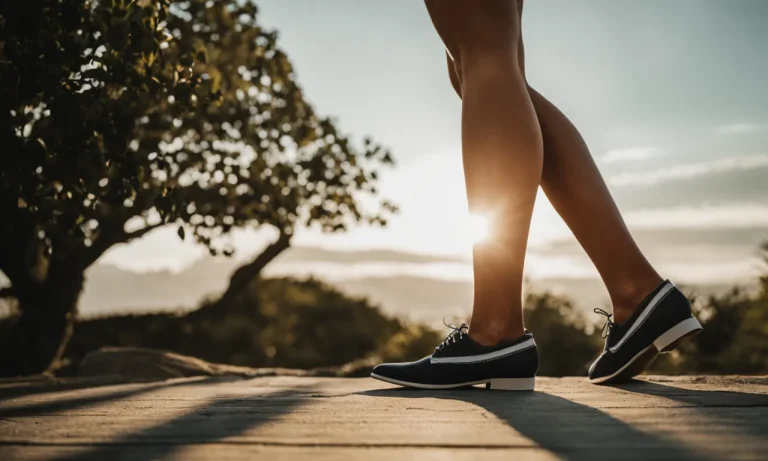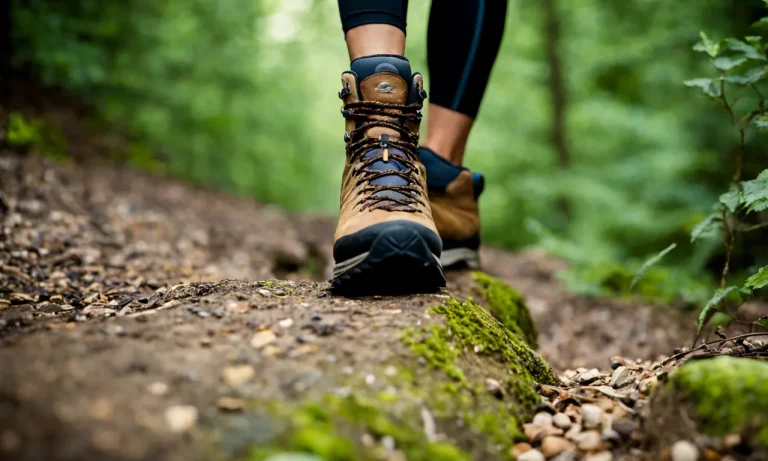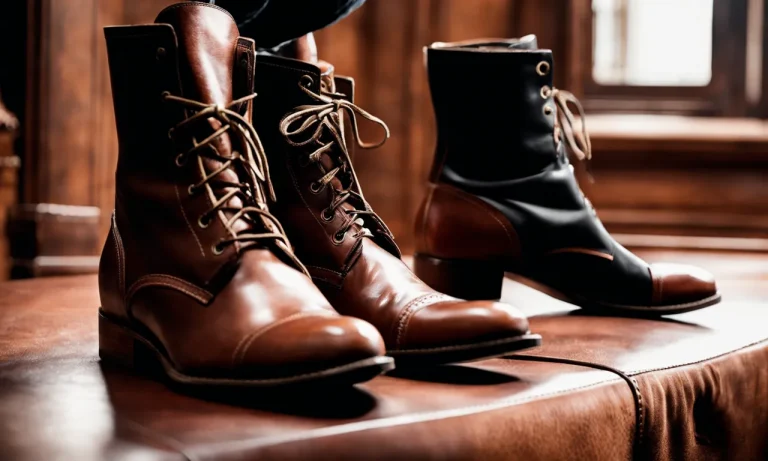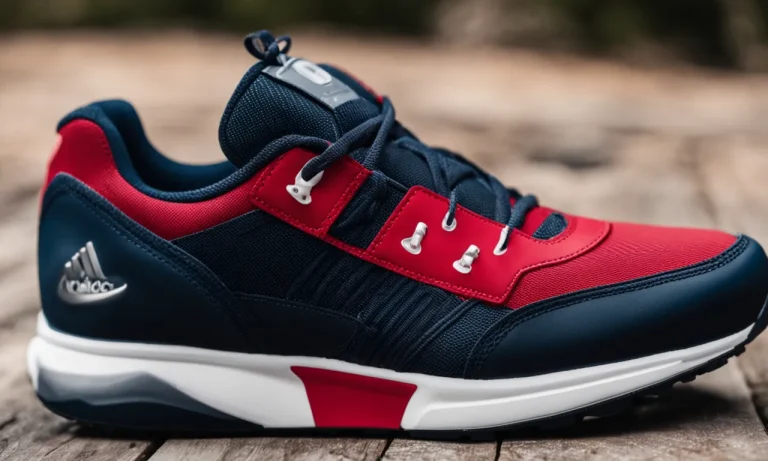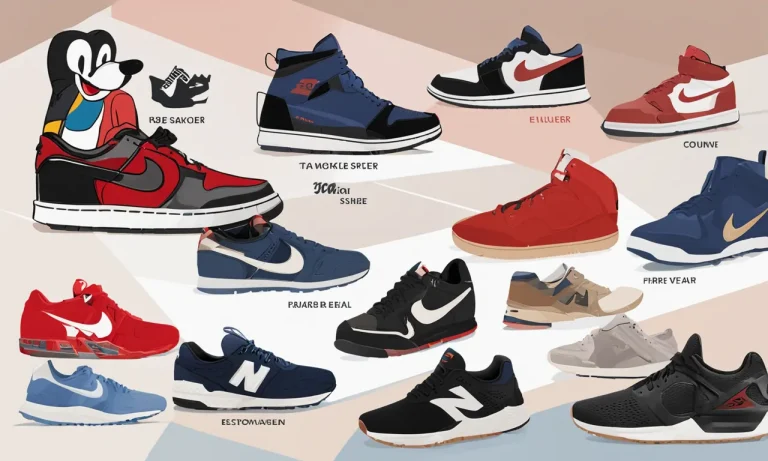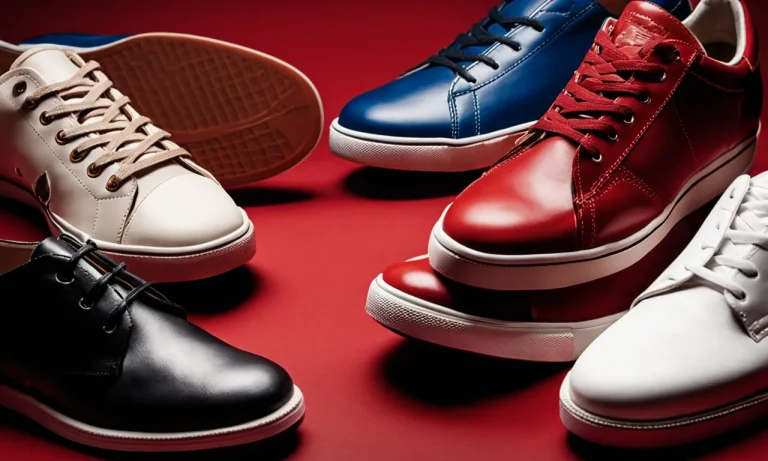Worn out boot soles can make walking difficult and even dangerous. Knowing when it’s time for new soles can extend the life of your boots and keep your feet comfortable.
If you’re short on time, here’s a quick answer to your question: Resole your boots when you notice excessive wear on the soles, such as worn down treads, cracks/holes, or when the footbed feels uneven. But for a more thorough guide, read on.
In this comprehensive guide, we’ll cover when and how to identify when it’s time to resole your boots. We’ll provide tips on how to make your soles last longer between resolings and discuss the pros and cons of different resoling options.
Signs That It’s Time for New Soles
Worn Down Treads
One of the most obvious signs that it’s time to resole your boots is when the treads have become significantly worn down. You can easily check this by examining the bottom of your boots. If the treads are flat or have little to no texture left, it’s a clear indication that the soles are no longer providing the necessary traction.
This can be especially dangerous on slippery surfaces, as it increases the risk of slips and falls.
Cracks or Holes in Soles
If you notice any cracks or holes in the soles of your boots, it’s definitely time to consider getting them resoled. Cracks and holes can not only compromise the structural integrity of the boots, but they can also allow water, dirt, and other debris to enter, making your feet susceptible to moisture and discomfort.
It’s important to address these issues promptly to prevent further damage.
Uneven Wear
Uneven wear on the soles of your boots can be another sign that it’s time for new soles. If you notice that the treads on one side of the boot are significantly more worn down than the other side, it could indicate an imbalance in your gait or the way you distribute your weight when walking.
Resoling your boots can help correct this imbalance and extend the overall lifespan of your footwear.
Slippery Soles
If you find that your boots have become increasingly slippery on various surfaces, it’s a clear indication that the soles have lost their grip. This can happen over time as the tread wears down or if the soles have become hardened from exposure to certain chemicals or extreme temperatures.
Resoling your boots with a new set of treads can restore their traction and improve your overall safety.
Remember, the best time to resole your boots is when you start noticing any of these signs. Ignoring them can lead to further damage and potentially jeopardize your comfort and safety. It’s always a good idea to consult with a professional cobbler who can assess the condition of your boots and recommend the appropriate resoling options.
Factors That Impact Sole Wear
When considering the best time to resole your boots, it’s important to take into account several factors that can impact the wear and tear on the soles. These factors include boot use frequency, walking surfaces, foot strike pattern, and sole material.
Boot Use Frequency
One of the primary factors that can affect sole wear is the frequency with which you use your boots. If you wear them every day for long periods of time, the soles are likely to wear down more quickly. On the other hand, if you only wear them occasionally, the soles may last longer.
It’s important to assess your boot use frequency to determine when they may need to be resoled.
Walking Surfaces
The surfaces you walk on can also have a significant impact on the wear of your boot soles. Rough and abrasive surfaces, such as concrete or gravel, can cause faster wear and tear compared to smoother surfaces like carpet or grass.
If you frequently walk on uneven or harsh terrains, you may need to resole your boots sooner than if you primarily walk on softer surfaces.
Foot Strike Pattern
Your foot strike pattern can also play a role in the wear of your boot soles. Some individuals have a pronounced heel strike, while others have a more neutral or forefoot strike. Depending on your foot strike pattern, certain areas of the sole may wear down more quickly than others.
It’s important to be aware of your foot strike pattern and inspect your soles regularly to determine if resoling is necessary.
Sole Material
The type of material used for the soles of your boots can greatly impact their durability. Different materials have varying levels of wear resistance. For example, rubber soles are generally more durable and long-lasting compared to leather or synthetic materials.
It’s important to consider the type of sole material when determining the best time to resole your boots.
While these factors can provide guidance, the best time to resole your boots ultimately depends on individual circumstances. Inspecting the condition of your soles regularly and seeking professional advice from a cobbler can help ensure that you make the right decision.
Remember, it’s always better to resole your boots sooner rather than later to prevent further damage and extend their lifespan.
When to Resole Based on Boot Type
Work Boots
Work boots are designed to withstand heavy use and provide maximum protection in rugged environments. However, frequent use can result in worn-out soles, compromising their safety features. It is recommended to resole work boots every 6 to 12 months, depending on the intensity of use.
If you notice signs of significant wear, such as uneven tread or a lack of traction, it’s time to consider resoling your work boots. Regular maintenance and timely resoling can extend the lifespan of your work boots and ensure they continue to provide the necessary support and protection.
Hiking Boots
Hiking boots are subjected to various terrains and weather conditions, making them susceptible to wear and tear. The frequency of resoling hiking boots depends on the terrain you typically hike on and the distance covered.
As a general guideline, it is recommended to resole hiking boots every 500 to 1,000 miles. However, if you notice a decrease in traction or your boots are no longer providing adequate ankle support, it’s time to consider resoling them.
Regularly inspecting your hiking boots and addressing any signs of wear can prevent discomfort and potential injuries during your outdoor adventures.
Winter Boots
Winter boots are designed to keep your feet warm and dry in cold and snowy conditions. The soles of winter boots are often made of rubber or other materials with enhanced traction to provide grip on slippery surfaces.
While the durability of winter boot soles varies, it’s recommended to resole them every 2 to 3 years. However, if you notice any cracks or the tread is worn down, it’s important to have them resoled sooner.
Proper maintenance, such as cleaning off salt and other debris, can also extend the lifespan of your winter boots.
Cowboy Boots
Cowboy boots are not only a fashion statement but also functional footwear for those who work on ranches or ride horses. The frequency of resoling cowboy boots depends on the material and usage. Leather soles may need to be resoled more frequently, typically every 1 to 2 years, while rubber soles may last longer.
Signs that your cowboy boots need to be resoled include uneven wear patterns or a lack of grip. Taking care of your cowboy boots by regularly cleaning and conditioning them can help prolong their lifespan and reduce the need for frequent resoling.
How to Make Your Soles Last Longer
When it comes to taking care of your boots, one of the most important aspects is ensuring that the soles last as long as possible. Here are some tips and tricks to help you make your soles last longer:
Use Boot Rotators
Boot rotators are a great investment if you want to extend the life of your boot soles. These devices allow you to rotate between different pairs of boots, distributing the wear and tear evenly among them.
By alternating between boots, you can prevent excessive wear on one pair and prolong the lifespan of your soles.
Clean Soles Regularly
Regularly cleaning your boot soles is crucial for maintaining their longevity. Dirt, debris, and other substances can get trapped in the grooves of the soles, which can cause them to wear down faster. Use a soft-bristle brush or a toothbrush to gently scrub away any dirt or grime.
Additionally, be sure to remove any sticky substances that may have adhered to the soles, as these can cause damage over time.
Apply Protectants
Using a protectant can help shield your boot soles from damage caused by water, salt, and other elements. There are various protectants available on the market specifically designed for different types of materials, such as leather, rubber, or synthetic soles.
Be sure to read the instructions and choose a protectant that is suitable for your specific boots.
Install Toe Taps
To prevent excessive wear on the front part of your soles, consider installing toe taps. These small pieces of metal or rubber are attached to the front of the sole and act as a protective layer. They are particularly useful for people who tend to drag their toes when walking, as they can significantly reduce the wear and tear on the front of the sole.
By following these tips and incorporating them into your boot care routine, you can help extend the life of your soles and get the most out of your favorite pair of boots. Remember, taking care of your boots not only saves you money in the long run but also ensures that your feet are properly supported and protected.
Resole Options: Pros and Cons
Full Resole
When it comes to resoling your boots, a full resole is often the most recommended option. This involves replacing the entire sole of the boot, providing a fresh and sturdy foundation for your footwear. One of the main advantages of a full resole is the durability it offers.
With a new sole, your boots will be able to withstand more wear and tear, extending their lifespan significantly. Additionally, a full resole provides optimal traction, ensuring you can navigate various terrains with ease.
However, it’s important to note that a full resole can be more expensive compared to other options, so consider your budget before making a decision.
Half Resole
If you’re looking for a more cost-effective option, a half resole might be the way to go. With a half resole, only a portion of the sole is replaced, typically the heel area. This option is ideal if the heel is the most worn-out part of your boots.
It can help restore stability and prevent further damage, while also saving you some money. However, keep in mind that a half resole may not provide the same level of durability as a full resole. If the rest of the sole is showing signs of wear, it’s best to opt for a full resole to ensure the longevity of your boots.
Topy Treatment
The Topy treatment is a popular alternative to traditional resoling methods. It involves adding a thin rubber sole on top of the existing sole, providing extra protection and grip. This option is particularly beneficial for those who want to preserve the original aesthetics of their boots, as the Topy treatment is less intrusive compared to a full or half resole.
Additionally, it can be a more affordable option and is often quicker to complete. However, it’s important to note that the Topy treatment may not be as durable as a full or half resole. It’s best suited for individuals who primarily need additional traction and minor sole protection.
When deciding on the best resole option for your boots, consider factors such as the extent of wear, your budget, and the specific needs of your footwear. Consulting with a professional cobbler can provide valuable insights and recommendations based on the condition of your boots.
Remember, investing in proper maintenance and resoling can greatly extend the life of your favorite pair of boots, saving you money in the long run.
Conclusion
Knowing when to resole your boots is important for foot health, safety, and extending the life of your footwear. Pay attention to signs of excess wear and damage, and consider resoling at the first signs your treads need replacing.
With proper care between resolings, you can maximize the time between repairs.
Resoling boots before the damage is too severe can get you back on your feet quickly, whether you’re working, hiking, or dancing the night away.

